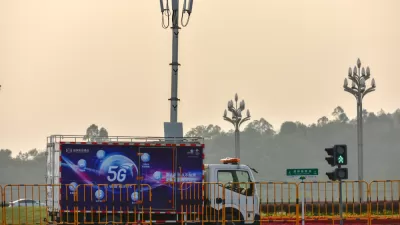Recent reporting shows the U.S. falling behind its neighbors in both smart city deployments and 5G network rollouts—the latter of which is slated to be the connective tissue of these future cities. The news has some experts on edge.

Smart cities are either going to be the pinnacle of modern living or an Orwellian nightmare, but one thing seems for sure: the United States probably isn’t going to be the first to find out.
Recent reporting underscores that the United States has fallen behind its neighbors in both smart city deployments and 5G network rollouts—the latter of which is slated to be the connective tissue of these future cities. The news has some experts on edge.
"China is developing 500 smart cities – almost half of the world’s total and more than 10 times North America’s figure," according to Graham Allison, the former director of the Belfer Center for Science and International Affairs, Harvard Kennedy School, writing in a recent Axios article. In contrast, Allison continued, "the U.S. is developing 40 smart cities, less than 4% of the globe’s total."
The IDC tells a similar story in the recently released "Worldwide Semiannual Smart Cities Spending Guide." In the United States, only four cities (New York, Los Angeles, Washington, D.C., and Chicago) are forecast to spend more than $300 million on smart city programs this year. Meanwhile, 11 cities in China will exceed the $300 million level in 2019.
What about the race to build 5G networks, which have faster speeds, higher throughput, and are considered the backbone of the internet of things, smart cities, and even autonomous vehicles?
The Defense Innovation Board, a who’s-who of tech royalty that advises the Defense Department, met in April and published a critical report on the country's 5G effort, effectively confirming that Beijing has taken the lead.
"The country that owns 5G will own many of these innovations and set the standards for the rest of the world… [and] that country is currently not likely to be the United States," wrote the board, which includes former Alphabet chairman Eric Schmidt, LinkedIn founder Reid Hoffman, and Walter Isaacson, a former chief executive of the Aspen Institute.
They have a point: according to patent analytics firm IPlytics [pdf], the United States is behind in the 5G patent race. The Chinese 5G market accounts for 34% of all 5G patents and technology; South Korea accounts for 25%. Trailing behind those two countries are the United States and the European Union--both of which account for 14% of the 5G market.
I.P. ownership aside, the Unite States isn’t faring much better when it comes to building out 5G networks.
“If you count the launch of commercial service in any form, the U.S. is in front of China,” writes Elizabeth Woyke in a December article for the MIT Technology Review. Both countries have carriers that claim to have introduced early 5G services to a limited number of mobile customers.
On the other hand, Woyke continued, "if you think a country needs to roll out 5G to all its major cities in order to claim leadership, China looks likely to come out ahead."
China Tower, a company that builds infrastructure for the country’s mobile operators, has said it can cover China with 5G within three years of the government's allocation of spectrum.
"That points to national coverage by 2023," warns Woyke. Based on the tone of the Defense Innovation Board report, it doesn’t seem likely the United States can compete with that timeline.
AT&T, for example, plans to cover nearly two-thirds of the U.S. population with 5G by 2021; Verizon has similar plans. However, at this point, there is no clear path to full national coverage in the United States.
Complicating the rollout in the United States are the 80 cities and counties suing the FCC over new rules designed to accelerate the buildout of America's 5G infrastructure. The rules limit municipal authorities to charging $270 per cell site per year and also impose a "shot clock" limiting how long authorities can take to review installation requests.
The FCC argues that the new rules will free up $2 billion in capital for wireless providers to use in underserved areas like rural communities; cities are claiming the federal government has overstepped its bounds, undercutting local control of infrastructure.
Further slowing the 5G rollout in U.S. communities are health concerns. The service will require thousands of small cell antennas placed throughout cities, and critics have said that the radiation could increase the risk of cancer, fatigue, headaches and other effects—claims that lack scientific support.
The National Cancer Institute recently weighed in, summing up the field of concern by saying a "limited number of studies" showed evidence of a"“statistical association of cell phone use and brain tumor risks," but added that "most studies have found no association."
Long story short, it’s not looking so good for the United States right now. Underinvestment in smart city deployments—relative to other countries—coupled with a forecast of a long 5G rollout and low patent ownership is unnerving some experts.
Then again, there may be a silver lining to this tale. After all, in the event these cities do turn into Orwellian nightmares, who would want to be the first to find out anyway?

Maui's Vacation Rental Debate Turns Ugly
Verbal attacks, misinformation campaigns and fistfights plague a high-stakes debate to convert thousands of vacation rentals into long-term housing.

Planetizen Federal Action Tracker
A weekly monitor of how Trump’s orders and actions are impacting planners and planning in America.

In Urban Planning, AI Prompting Could be the New Design Thinking
Creativity has long been key to great urban design. What if we see AI as our new creative partner?

King County Supportive Housing Program Offers Hope for Unhoused Residents
The county is taking a ‘Housing First’ approach that prioritizes getting people into housing, then offering wraparound supportive services.

Researchers Use AI to Get Clearer Picture of US Housing
Analysts are using artificial intelligence to supercharge their research by allowing them to comb through data faster. Though these AI tools can be error prone, they save time and housing researchers are optimistic about the future.

Making Shared Micromobility More Inclusive
Cities and shared mobility system operators can do more to include people with disabilities in planning and operations, per a new report.
Urban Design for Planners 1: Software Tools
This six-course series explores essential urban design concepts using open source software and equips planners with the tools they need to participate fully in the urban design process.
Planning for Universal Design
Learn the tools for implementing Universal Design in planning regulations.
planning NEXT
Appalachian Highlands Housing Partners
Mpact (founded as Rail~Volution)
City of Camden Redevelopment Agency
City of Astoria
City of Portland
City of Laramie





























